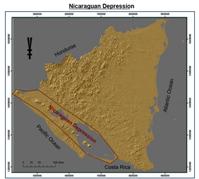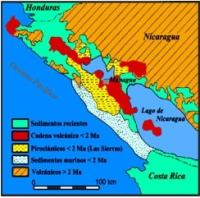Special Program for International Students
GRADUATE COURSE IN EARTH SCIENCE
& GEOENVIRONMENTAL SCIENCE
Current IDB students
Melida Pilar Schliz Antequera (Nicaragua)
Email: s099215 @matsu.shimane-u.ac.jp
Thesis title: Analogue models of the Nicaraguan Depression: intra-arc rifting and related volcanic activities.
Supervisor: Prof . H. Komuro (2009-2011).
The Nicaraguan Depression is one of the most outstanding geologic features of Central America, and contains a Quaternary volcanic arc. The rocks that characterize the area are Holocene sediments and volcanic rocks that were produced by the activity of this arc. Smith and Landis (1995) described the Nicaraguan Depression as an intra-arc rift basin in the convergent zone between the oceanic Cocos plate and the continental Caribbean plate. Weinberg (1992) proposed that the Nicaraguan Depression began to form in the Lower Pliocene. However, the rifting mechanism in the compressional convergent zone and associated volcanic activity have not yet been clarified.
The aim of this project is to study the mechanisms of formation of the Nicaraguan Depression by experimentation with analogue models. This analysis will help to give a more exact structural classification of the Nicaraguan Depress, and will therefore contribute to the regional geology of Central America.
Spanish
La Depresión Nicaragüense es uno de los rasgos geológicos más destacados de América Central junto con el Arco Volcánico Cuaternario que contiene. Las rocas que caracterizan el área son sedimentos de edad Holoceno y rocas volcánicas producto de la actividad del Arco Cuaternario. Smith y Landis (1995) señalaron que la depresión Nicaragüense es una cuenca de fisura intra-arco en la zona de convergencia entre la placa oceánica Coco y la placa continental Caribe. Weinberg (1992) propuso que la Depresión comenzó su formación en el Plioceno Inferior. Sin embargo, los mecanismos de fisura en la zona compresional de convergencia y la actividad volcánica asociada no han sido aclarados.
El objetivo de este proyecto es estudiar los mecanismos de formación de la Depresión Nicaragüense mediante la experimentación por modelos análogos. Este análisis ayudará a dar una clasificación estructural más exacta de la Depresión Nicaragüense y por ende un aporte a la geología regional de América Central.



